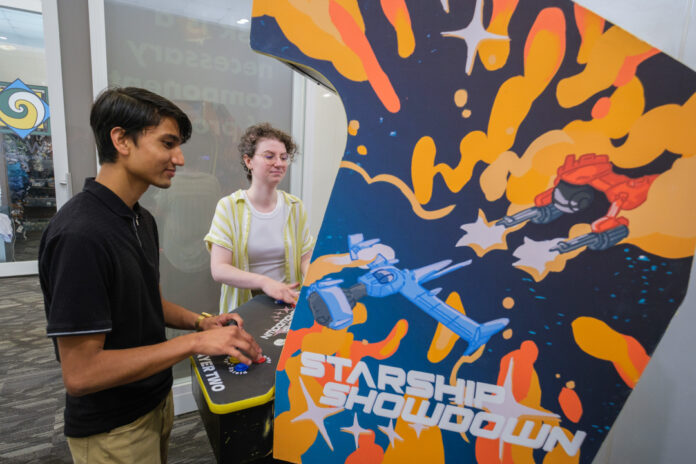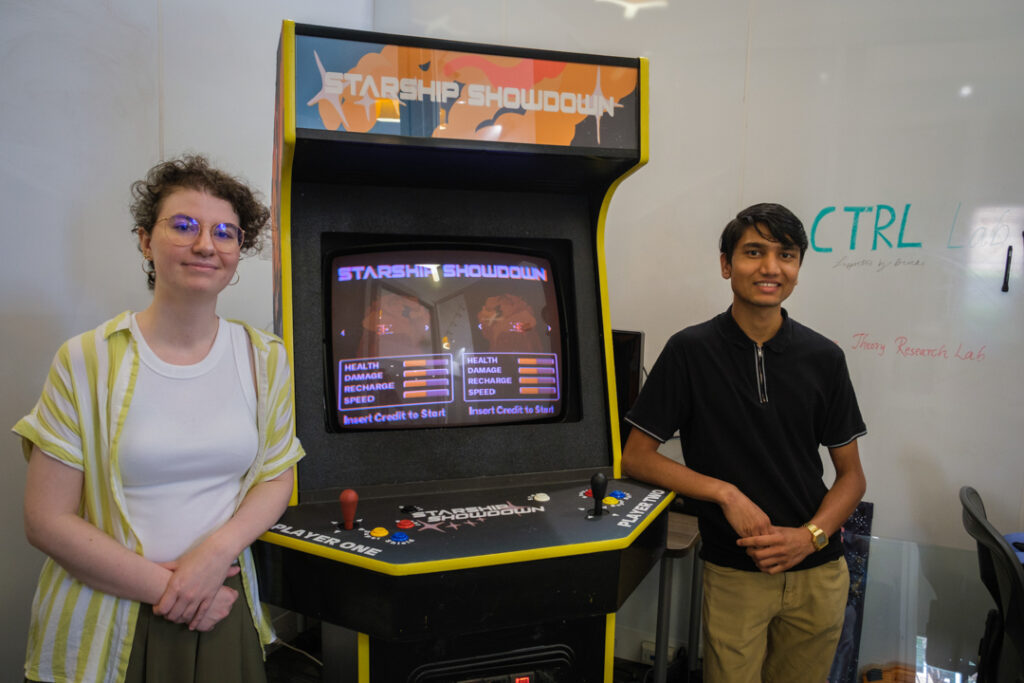
The pixelated graphics, electronic music and joystick controls of Starship Showdown make it feel like a classic arcade game. But the two-player game was actually created in 2024 by two Mercer University students who weren’t even alive during the arcade’s heyday.
Juniors Rajwol Chapagain and Maret McWhorter created the game from scratch as part of the communication theory research lab in the Department of Communication Studies and Theatre Arts. They debuted Starship Showdown at Bear Day in the spring.
“It follows in the footsteps of something like Asteroids,” Chapagain said, referring to the popular space-themed arcade video game that debuted in 1979. “I wanted to have a game where the movement mechanics were similar to Asteroids, where you feel like you’re moving around in space, but I wanted it to be multiplayer, because multiplayer makes it more fun, and I wanted it to be competitive.”
In Asteroids, a single player controls a spaceship, with the goal of shooting asteroids and flying saucers. In Starship Showdown, two players each control their own spaceship and duel with each other for three rounds. Whoever wins two rounds wins the game.
Chapagain started the project in September 2023 and brought on McWhorter in January. The pair discovered they made a good team after working together to make a browser-based minigame in their video game studies class taught by Dr. Cameron Kunzelman, assistant professor of communication studies and director of the communication theory research lab.
Dr. Kunzelman, a game studies and science fiction scholar, approached Chapagain about designing an arcade video game after Reboot Retrocade in downtown Macon donated an arcade game cabinet to the lab.

Chapagain, a Stamps Scholar double-majoring in computer science and communication studies, handled the technical aspects of development. McWhorter, a communication studies and creative writing double-major, did the visual design. Both students are in the Mercer Honors program.
McWhorter, from Milton, also brought extensive video game experience to the table. The art minor plays a variety of modern video games and grew up playing arcade games in a family friend’s basement. Chapagain, meanwhile, is less of a gamer and hadn’t even seen an arcade game until he took the video game studies class.
“I’m from Nepal. There were not that many arcades there. I’d never seen an arcade cabinet in my life,” he said.
The arcade game development process included coming up with an idea, creating a prototype, play testing, developing the game, and integrating it into the hardware. The project also involved lots of research and problem-solving, particularly when it came to integrating modern technology with the arcade cabinet’s older hardware.
“We were taking a new microcomputer and making it talk to arcade hardware that’s 30 years old. That requires some unique parts that we had to research and source,” Dr. Kunzelman said. “Mostly, people are trying to play old games and capture feelings of nostalgia in the arcade space. We were one of the very few people trying to make a new game old.”
Games are a form of communication, although they aren’t yet talked about in the same way as written, oral and visual communication, Dr. Kunzelman said.
The communication theory research lab offers students a chance to explore games as an academic subject and participate in research that could lead to a career in the gaming industry, he said. Or it could lead students to pursue game development as a hobby, like one might pursue writing or art.
“We have a lot of students who are interested in games,” he said. “I’m hoping communication studies can be a central hub for that.”
The arcade video game project came together with the help of many throughout the University, Dr. Kunzelman said.
“College of Liberal Arts and Sciences Dean Dr. Tom Scott contributed funding and support, School of Business Dean Dr. Julie Petherbridge has graciously given us space in the Mercer Innovation Center to work on the physical cabinet, and the art department helped us format and print the large vinyl decals that really make the cabinet pop,” he said. “This is the kind of collaboration that is only possible at a place like Mercer, where we’re only an email, phone call, or a few hundred yards from excited partners who really want to make applied undergraduate research possible.”









